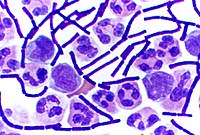
Photo from wikipedia
BACKGROUND Multi-drug-resistant bacteria such as Methicillin-resistant Staphylococcus aureus (MRSA) disseminate rapidly amongst patients in healthcare facilities and suppose an increasingly important cause of community-associated infections and associated mortality. The development… Click to show full abstract
BACKGROUND Multi-drug-resistant bacteria such as Methicillin-resistant Staphylococcus aureus (MRSA) disseminate rapidly amongst patients in healthcare facilities and suppose an increasingly important cause of community-associated infections and associated mortality. The development of effective therapeutic options against resistant bacteria is a public health priority. Plant polyphenols are structurally diverse compounds that have been used for centuries for medicinal purposes, including infections treatment. Based on the existing evidence on the polyphenols' antibacterial capacity, polyphenols may be postulated as an alternative or complementary therapy for infectious diseases. OBJECTIVE Review the antimicrobial activity of plant polyphenols against Gram-positive bacteria, especially against S. aureus and its resistant strains. Determine the main bacterial molecular targets of polyphenols and their potential mechanism of action. METHODOLOGY The most relevant reports on plant polyphenols' antibacterial activity and their putative molecular targets were studied. We also performed virtual screening of thousand different polyphenols against proteins involved in the peptidoglycan biosynthesis to find potential valuable bioactive compounds. RESULTS Several polyphenols: phenolic acids, flavonoids (especially flavonols), tannins, lignans, stilbenes and combinations of these in botanical mixtures, have exhibited significant antibacterial activity against resistant and non-resistant Gram-positive bacteria at low µg/mL range MIC values. Their mechanism of action is quite diverse, targeting cell wall, lipid membrane, membrane receptors and ion channels, bacteria metabolites, and biofilm formation. Synergic effects were also demonstrated for some combinations of polyphenols and antibiotics. CONCLUSION Plant polyphenols mean a promising source of antibacterial agents, either alone or in combination with existing antibiotics, for the development of new antibiotic therapies.
Journal Title: Current medicinal chemistry
Year Published: 2018
Link to full text (if available)
Share on Social Media: Sign Up to like & get
recommendations!